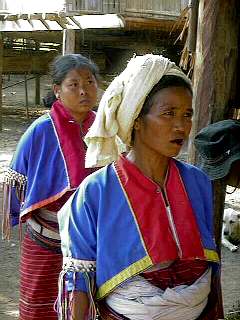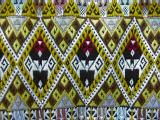 THE
HILL TRIBES OF THAILAND THE
HILL TRIBES OF THAILAND There are six main hill tribes who live in Thailand -- the Yao (or Mien), Akha, Lahu, Hmong, Lisu and Karen -- and several smaller ones, such as the Padong, L'wa and the Kha Mu. (There also remain a small number of Phi Tong Luang, one of the world's last remaining bands of hunter-gatherers; most live in southern Thailand, and are referred to as "orang asli" or "original people.) While each tribe has its own language, its own specific set of traditions and beliefs, and its own very distinctive style of dress, they also share many notable characteristics. All the tribes come originally from the mountains of Tibet and southern China (Yunnan province), from where they were pushed by political repression, warfare and/or the need for new land. They moved along the mountain ridges into Thailand, staying in the upland areas where they settled in villages along the mountain slopes and in the upland valleys. They are farmers, and grow rice and corn for their own subsistence as well as cash crops ranging from coffee and tea to peanuts, soy beans, tobacco and a wide variety of fruits. Many of the villages used to grow opium, but that practice has been almost completely stopped by the government, mostly through a program where the tribes are given substitute crops to grow. They are semi-nomadic, which means that while they live in a settled village, they frequently move the village to a new place when the one they're on becomes less productive for farming. Almost all practice slash-and-burn cultivation, where they cut down the forest and burn the trees to create new farmland (* see below). Besides farming, men in the villages also hunt and fish, and women gather everything from foods (mushrooms, bamboo shoots, roots and nuts) to firewood and grass for thatching. Work is shared (for example, new homes are built by the entire village), and there are many communal events. Families are very important, and respect for elders is a strongly-held value. This is also reflected in the political organization of the villages, which is very egalitarian -- there is a headman to provide guidance, and often a council of elders to help, but they usually do not have any more in the way of possessions than any others in the village. Hill tribes can easily be identified by their distinctive, beautiful clothing, though these days they are usually worn only during special celebrations. They also have their own individual styles of music and dance, and while all the tribes practice spirit worship, each has its own unique and very complex set of beliefs and practices related to the spirit world. Many, but not all, have a village priest, who takes charge of the ritual life of the village, and a shaman, who has special powers to communicate with the spirit world. The Thai government has an official policy that gives full rights to the hill tribes to practice their religion and maintain their culture. In actuality, there is a lot of pressure for the hill tribe peoples to assimilate into mainstream Thai culture. The fact that they've survived and maintained their identity under such pressures to adapt and assimilate into the modern world of Thai society that surrounds them is, I think, a testament to the wisdom of their ways. The world would suffer a great loss if that wisdom were to disappear. *From the way it sounds, most people think that "slash-and-burn" must be a terrible way to use the land. However, if it's done in the right way, slash-and-burn can be a very effective way to farm, and does little damage to the environment. (After all, the hill tribes have been doing it for hundreds of years!) It's effective because the ash is great fertilizer. It's responsible (IF done properly) because the tribe usually uses very little of the forest at one time, and after they move on that area becomes reforested. The problem today is that hill tribe populations are growing fast, and the larger numbers of people are using up more and more forest more and more quickly. So, the necessity to manage the land effectively is a big challenge to the government of Thailand and to the hill tribe people themselves. |
This page is maintained by Todd Greenspan for Avi Black
Comments and suggestions welcome.
Last updated
